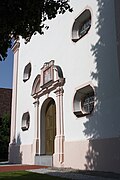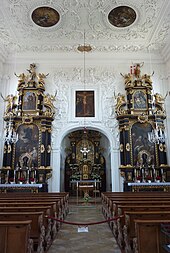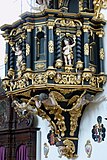Our Lady (Münsterhausen)
The Catholic pilgrimage church of Our Lady in Münsterhausen , a community in the district of Günzburg in the Bavarian administrative district of Swabia , is a baroque church, the nave of which was built at the beginning of the 18th century. The Chapel of Grace, built at the end of the 17th century, serves as the choir , in which the miraculous image , a replica of the Black Madonna of Altötting , is venerated.
history
The southern district of Hausen is first mentioned in 1071 as a property of the Augsburg bishopric . In 1507 a chapel with the patronage of St. Leonhard is attested. As early as the early 17th century there was another chapel, which was attached to the Leonhard Chapel and consecrated to Our Lady . At the end of the 17th century, Baroness Johanna Franziska von Heidenheim had a Chapel of Mercy built in her place based on the model of Altötting , in which she had a Madonna and child based on the Altötting image in 1699.
The nave of today's pilgrimage church was built from 1703 to 1708 on the site of the abandoned Leonhard Chapel and consecrated in 1708 by the Augsburg auxiliary bishop Johann Kasimir Röls . Valerian Brenner , who lives in Günzburg, is believed to be the master builder . In the course of the renovation in 1901/02, the east wall of the nave, which originally could only be opened through a door and a window to the chapel of grace, was broken through and the chapel of grace was set up as a choir .
architecture
Exterior construction
The west facade designed as a show side has a volute gable divided by cornices , which is crowned by an octagonal roof turret with an onion dome. The lower gable field is broken up by two semicircular drawn out rectangular windows. In the middle of the west facade is the now walled up, former main portal, which is framed by pilasters and covered with a gable . Three transversely oval windows, one above the other, open on both sides.
inner space
The single nave nave is flat-roofed and closes in the west with a double gallery . The walls are divided into stucco frames, retracted arched windows and pilasters with Ionic capitals . A basket arch opens to the east to the Chapel of Mercy, used as a choir, which is built over an octagonal floor plan. Semicircular niches have been cut into its walls, over which arched windows open.
Stucco and ceiling painting
The stucco decor of the nave was created shortly before 1708 and is assigned to the Wessobrunn school . Acanthus tendrils cover the ceiling, oak leaves and laurel frame the fields. Angels hold the coats of arms of the founders, the Heidenheimer and Weldener families.
The ceiling paintings, painted in oil on canvas, also date from 1708. The central picture is dedicated to the coronation of Mary by the Holy Trinity . The images on the side show the Annunciation and the birth of Christ above the gallery and in front of the choir of the Assumption of the Virgin and Mary Immaculate .
The grisaille frescoes , like the stucco decoration and the ceiling frescoes of the Chapel of Mercy , were executed in 1901/02.
Furnishing
The high altar dates from the renovation in 1901/02. The relief tablet made of silver and gold sheet and the miraculous image of the broken off previous altar were taken over into the neo-baroque structure by Georg Saumweber . Angels with banners are depicted on the relief, God the Father and God Son hold a crown over which the dove of the Holy Spirit hovers. It crowns the miraculous image in the altar niche.
The black and gold framed structures of the side altars have been preserved from the time the church was built. The altar leaves by Matthias Pußjäger (1654–1734) from Rottenbuch depict St. Leonhard on the left and the Lamentation of Christ on the right . The excerpts crown St. Sebastian on the left and a Christ of the Resurrection on the right .
The pulpit is marked 1708. The pulpit is decorated with putti , which symbolize the virtues of faith, hope and love through their attributes . The bottom of the basket pulpit adorn Engels hermen , the sound cover is surmounted by a trombone Engel, the structure is with the figures of the four evangelists provided. On the edge stand putti holding vines, laurels and roses in their hands.
literature
- Georg Dehio (revised by Bruno Bushart and Georg Paula): Handbuch der deutschen Kunstdenkmäler. Art monuments Bavaria III: Swabia . Deutscher Kunstverlag, Munich 1989, ISBN 3-422-03008-5 , p. 744.
- Karin Hösch: Catholic pilgrimage church of Our Lady . In: Münsterhausen. Parish Church of St. Peter and Paul. Munsterhausen. Our Lady . Peda art guide No. 479/2000, Art Publishing House Peda , Passau 2000, ISBN 3-89643-137-4 .
Web links
- Frauenkirche administrative community Thannhausen
Coordinates: 48 ° 18 ′ 29 ″ N , 10 ° 27 ′ 22.5 ″ E








